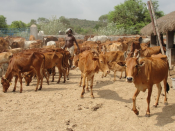Urbanization and increased demand for land

Introduction
Go Samarakshanam and Veda Samrakshanam are the two pillars of Hinduism and our culture.
Mahaswamigal of Kanchi has emphasized the importance of both throughout His life and it can be rightly said that He considered them as“ His two eyes”.
At a time when people had totally forgotten about our duties towards the above, the Mahaswamigal made yeomen efforts to resurrect them
The efforts towards Veda Samrakshanam got a lot of focus and several Veda patasalas sprang throughout the country. The number of vedic pandits(vaideehas) has increased substantially over the years and hence conduct of vaideeha karmas has become easier. However, not much was done for GoSamrakshanam due to various reasons.
Mahaswamigal of Kanchi lamented this fact and spoke with anguish on several occasions about the need for Gosamrakshanam.
During the last few decades, due to
-
-
Mechanization of farming
-
Use of chemical fertilizers
-
Emphasis on high milk yielding foreign breeds (which cannot be considered as cows)
-
Slaughter of cows for meat and leather industries
the dependence on cows as the base of our agriculture reduced drastically. Absence of manpower at the village level and loss of grazing lands added to the problems and our native breed of cows got decimated.
Sri Mahaperiyava of Kanchi on Cow and Yagya:
“The Welfare of the entire world depends on the Vaideeha yagya karma anushtanams perfomed in India.There need not be any doubts in this matter. The entire world exists because of yagya. Two things are necessary for Yagya. One is the “karta” of yagyam;the other is the “cow” which gives all the dravyas used in the yagya. When mantras are not simply recited as Japas,but along with the kriya called Yagya, then only the combined power of Mantra and Dravyas can give the full benefit of the yagya.
Therefore, if there is no cow, there is no Yagya.”
All the main ingredients used in Yagya- milk, ghee,curd,varatti(cowdung cake) are all products from the cow. Hence without the above, the Yagya cannot be complete and fruitful (all the products used currently in yagya are not purely from native cow breeds)
Therefore there is an urgent need to focus our attention, in a big way, on GoSamrakshanam of native Indian breed cows.
We must reach a situation where all yagyas will be performed using pure cow products to get the full benefit of Yagyas for the welfare of whole world.
The time to act is now.
